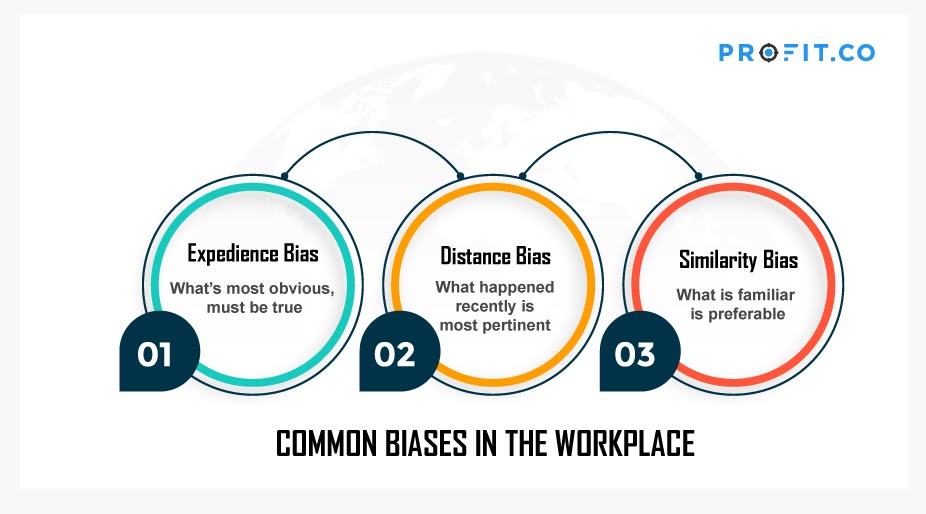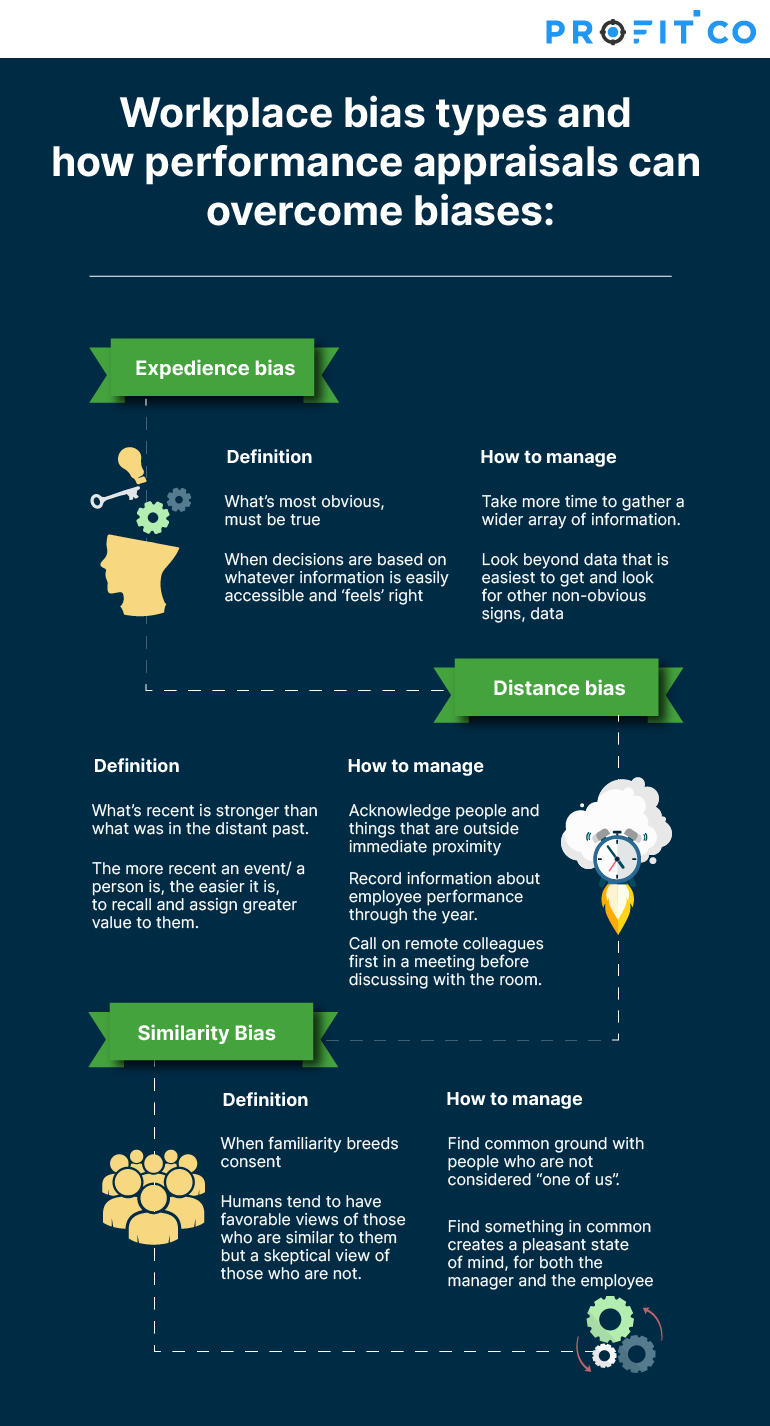Every organization follows an evaluation process that suits them the best depending on the kind of organization they are. However, irrespective of what the evaluation process is, they all follow a predictable format: employees write about their achievements and the areas where they can improve. Their managers then write an assessment of their work, offer feedback and rank their performance.
The idea behind this process is to go over the employee’s performance and assess it with an evaluation form with the objective of rewarding their performance justly, and offer useful feedback that will help them improve their performance and develop their skills. While the intention may be to follow a fair assessment process, it more than not, is biased.
The “open box” ambiguity
Everybody, by virtue of constantly seeking efficiency, is biased in some way. And not all biases come from a place of malice. As fair as the evaluation form may seem, it often allows for biases to creep in. The reason for this to happen is the ‘open box’. Most forms ask managers open ended questions about their employees—e.g., “Describe how the employee’s performance met expectations” or “What are their significant accomplishments?” with a blank space for the managers to fill out with their assessment and feedback. The open-endedness of these questions is by design so that it can apply to everyone in the organization, irrespective of function or level. So when an open-ended question is stated on the form, the manager is expected to figure out what the expectations were for that employee and how well they have been achieved. However, when the questions on the form are left open ended, it leaves much room for ambiguity. And when the context and criteria for making evaluations are ambiguous, bias is more prevalent. Studies have shown that without structure and clarity, people are more likely to base their decisions on gender, race and other stereotypes instead of giving constructive assessments.
Open ended questions = Open to bias
Ambiguity in how performance reviews are written can be disadvantageous for employees. Between men’s and women’s written performance reviews, women are more likely to get a vague feedback that did not offer specific details of how well their performance was and what they could do to be better at what they do. For example, women got shorter reviews and the feedback they most likely get are “do more work in person” without an explanation about how to overcome the issue. Men, on the other hand, were more likely to receive longer reviews that focused on their technical skills.
Managing biases
It is important to remember that annual performance evaluations play a significant role in shaping employees’ careers, salaries and lives and can affect their talents. Biases can affect an organization’s success. Performance reviews can be made fairer and more consistent, even if the organization does not change the evaluation form. What’s important is how we manage our biases.

Here are the most common types of biases, what they’re all about, and how to address them:
Expedience bias: What’s most obvious, must be true

Expedience bias makes us gravitate towards answers that seem obvious, often at the cost of answers that might be more relevant and objective. When we go with the “what gets measured is what gets managed” approach, we might be turning a blind eye to what’s truly useful.
For example: in the online publishing space, a writer’s capability might get measured solely on traffic, rather than assessing the quality of the writing.
In sales, it could be focusing solely on revenue targets, instead of evaluating how the quality of client relationships would drive future business.
How to address the bias:
To avoid Expedience Bias, look beyond the obvious. Look beyond data that is easiest to get and look for other non-obvious signs, data, and actions that contribute to success, or failure. Such as a person’s ability to manage a tough client, or motivate other team members, to achieve their goals. Talking to colleagues and peers across departments helps give a 360 degree picture of the employee’s performance.
Another way to avoid expedience bias is to conduct proactive reviews asking employees to state their goals ahead of the performance review. When the employee’s goals are clearly stated to the manager, it avoids expedience bias because now the data that’s available is very relevant and unambiguous.
To make this a success, it’s in the employee’s and manager’s interests to communicate clearly and early about the goal and begin monitoring it. The manager can keep track of how well the employee is performing and moving towards achieving his or her stated goals. The manager can guide and help the employee also to track themselves. When both the manager and employee are able to communicate freely, they’ll be able to track progress better, and also help the employee stay motivated to achieve their goals.
Distance bias: What’s recent is stronger than what was in the distant past

Distance bias is what happens when we tend to think people and events that are closer to us, in space or time, are more important than those that aren’t. The more recent an event, the easier it is to recall it. And therefore, we tend to assign greater value to those events as they’re at the forefront of our minds.
For example, it’s easier to recall how an employee handled the campaign last week or last month than it is to remember how s/he performed over the entire year. Even if the employee was a stellar performer the entire year, but slipped up just very recently because it was a tough campaign to handle, the manager might defer to recent performance because older ones take more effort to recall.
This kind of bias can have a very negative impact on the employee’s performance, and can hurt his or her career growth and in turn, the health of the company too.
How to address the bias
At the end of the year, it’s hard to remember the events from January, as clearly as those from October. Whether the employee’s performance has gone up or down, it doesn’t matter. The brain focuses on and remembers more recent events, and therefore considers them as being more important.
One way to avoid the distance bias from creeping into your evaluation process, is to record information throughout the year. Doing so helps the manager remember things that the employee did and how the manager felt about it at that moment in time. Recording information about employee performance through the year is a very powerful tool; something that would remind the manager how incredibly well the employee handled the client meeting back in March.
With this approach, by the time it’s time for the annual review, the manager will have a year’s worth of evaluations to refer to, rather than focusing on only the most recent event or performance.
Similarity Bias: We like what’s familiar

We tend to gravitate towards people who are like us. Separating people into groups is part of being human. The downside to this ‘grouping’ is that sometimes the criteria used is very superficial, like skin color, gender, race, community etc. to decide who is “one of us” and who’s not.
Similarity bias is when we favor people who in our minds and by our criteria, are like us. This is often at the expense of those who are not and for no fault of theirs.
In the workplace, for example, managers of a certain race can unknowingly devote more attention to people of the same race or of the same community. While the manager might claim to be completely unbiased to these similarities, employees who do not share these similar traits still must work much harder to get the manager to notice them, for they may otherwise run the risk of seeming like underperformers.
How to address the bias:
Managers need to be made aware that before conducting a performance review, they must find something that they have in common with the employee who is going to be reviewed. This re-orients the manager to see the employee as someone who is “one of us” as far as the manager is concerned, thus granting all the advantages of attention and perception that come with doing so.
For example, a manager of a certain race reviewing an employee of another race might begin discussing a work event they both participated in. It could be a team meeting or a quizzing event. Finding something in common puts both the manager and the employee in a pleasant state of mind, psychologically, due to having aligned interests and goals. Once this hurdle has been crossed, the manager can then focus on the employee’s accomplishments and ideas since he or she is now part of the manager’s “one of us” group.
Managers that work towards finding something common in conversations can make this a part of company culture, and a pleasant one at that. Employees in such an environment see one another as similar just by sharing similar goals and by being coworkers, regardless of appearance or belief or faith.
Profit.co
In the Profit.co software, there are numerous tools that can assist with avoiding these biases during performance reviews.
Profit.co supports two methods of performance review– standard reviews and affinity-based reviews. Standard reviews allow HR administrators to customize reviews with open-ended questions so that employees have ample opportunity to describe their experience and perspective on their performance during the review period. This can help managers recall events from earlier in the review period. Additionally, the opportunity to conduct a review virtually before meeting in person can help with similarity bias.
Affinity-based performance review asks reviewed employees, managers, and any selected peer reviews to rate an employee’s competencies— skills or attributes necessary for professional success. This 360-degree review method can offer multiple perspectives on employees, opening up the manager’s eyes to different opinions and perhaps helping to eliminate bias.
HR administrators can initiate performance reviews as frequently or infrequently as they see fit. Conducting a performance review is easier than ever, with automated prompts in the Profit.co software that help HR administrators keep tabs on the progress of reviews, and intuitive UI that makes conducting detailed and valuable reviews more efficient than ever.
In Summary
By addressing these biases, managers can make the evaluation process fairer.
Keeping biases in check and making sure the organization has inclusive practices so that everyone feels they can be heard is the way to go for a smarter, more successful organization.

